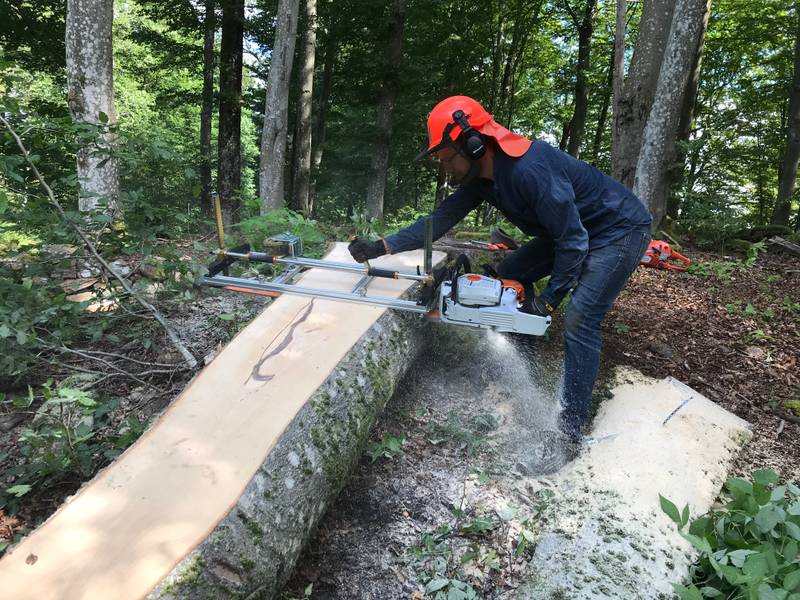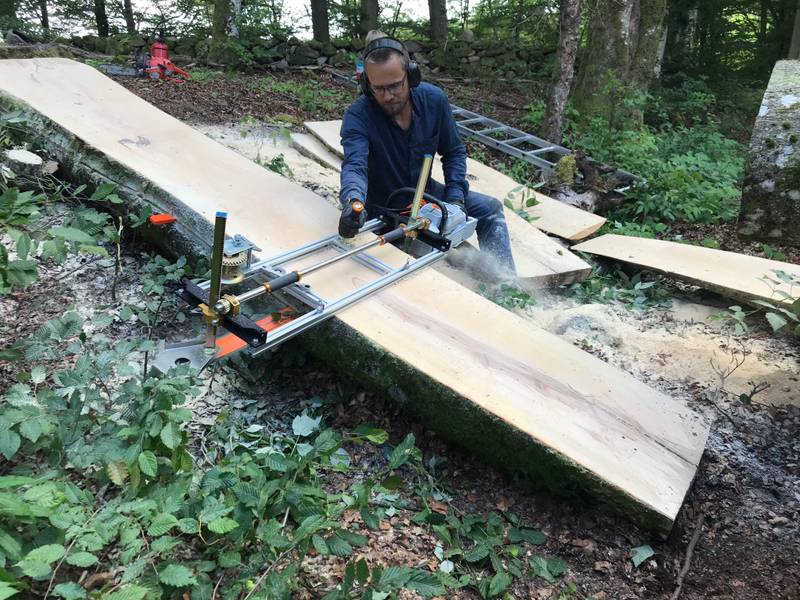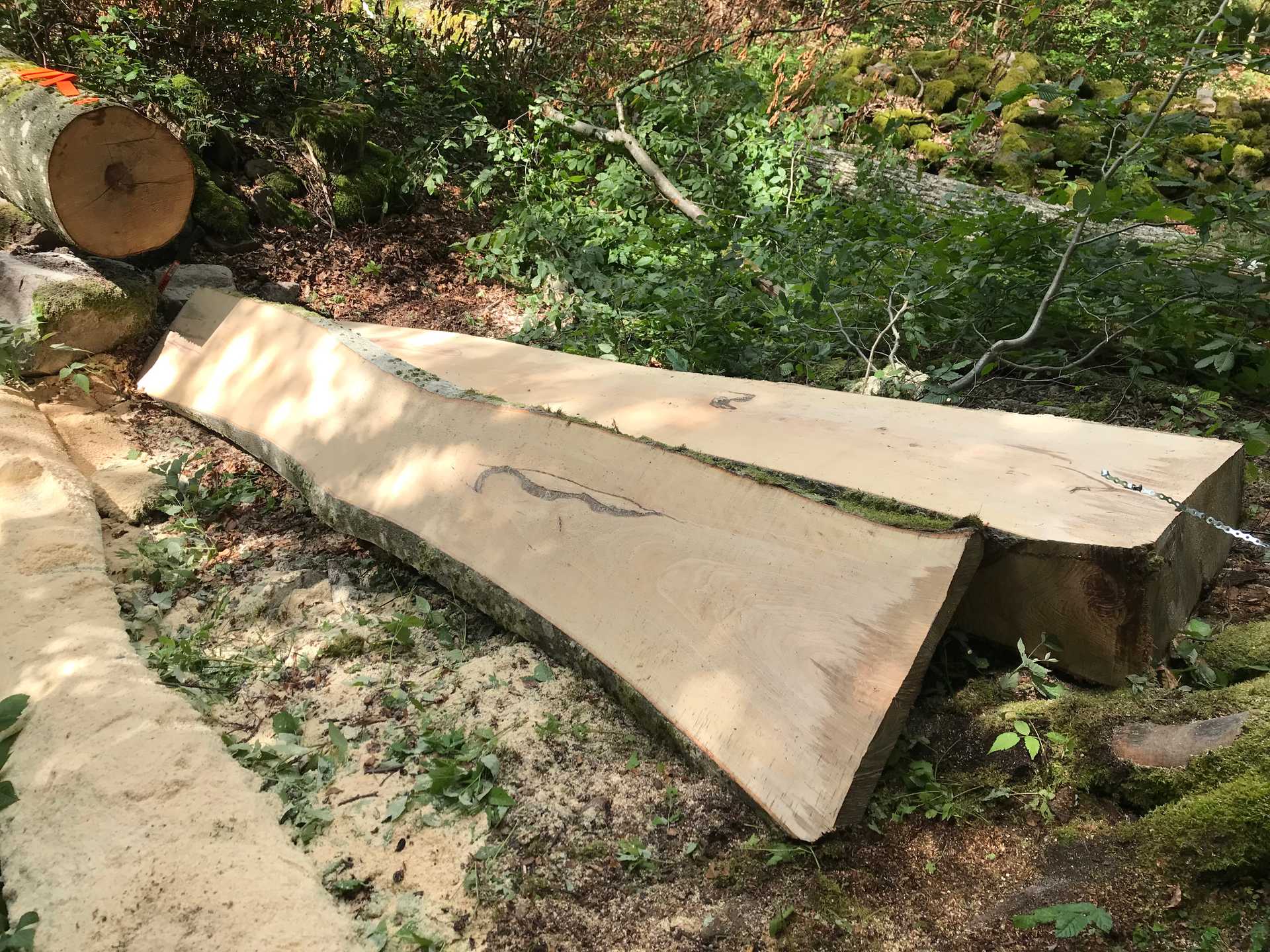There’s been a lot of back and forth wether we should buy a sawmill ourselves, rent it or simply have someone else fo it for us. In the end we decided to spend the money once and hopefully get years of nice lumber at a very low cost.
The sawmill
After months of research trying to decide on which sawmill to buy we ended up picking a sawmill from a small company in the UK. Their Panther sawmill was slightly more expensive than the Granberg alaskan sawmill but the difference wasn’t that much and with the full kits available with chain + bar it made the buying process pretty simple.
The model we ended up buying was the 42” size sawmill with a cutting capacity of 107cm. This should be plenty wide to mill up any of the trees on our property. The kit also include a GB sawbar and a Stihl chain low angle ripping chain.
The chainsaw
After the sawmill arrived we assembled it right away. However, at that point we were undecided on if we should rent or buy a chainsaw to use with it. After another week or so mulling over buying or renting we felt it made more sense to buy, thinking long term.
There was pretty much only one option in terms of chainsaw that would work with the sawmill we picked; the Stihl MS-661. Once ordered it arrived a week later we were quick trying to assemble everything. However, a certain chain sprocket didn’t have the correct size so we had ot order a new smaller clutch sprocket that would work with the chain we got on the sawmill.
So, long story short, after several weeks of reading, researching and deciding on wether to buy or rent we’re finally ready to start using it.
 The assembled Panther sawmill with the Stihl MS-661 chainsaw, and Mindy.
The assembled Panther sawmill with the Stihl MS-661 chainsaw, and Mindy.
The first cut
While Panther also sells a complete system for the first cut we opted for the more simple ladder approach as a first step. The set up was simple, we just laid the ladder on top of the beech log and secured it with 4 steel strips just tight enough for the ladder to not move but not too firm bending or skewing the ladder.
 The sawmill ready for the first cut resting on the 4m ladder.
The sawmill ready for the first cut resting on the 4m ladder.
 The log wasn’t completely straight and I guess we could have tried to roll it over but it was just too darn heavy and we didn’t have the proper tools for it.
The log wasn’t completely straight and I guess we could have tried to roll it over but it was just too darn heavy and we didn’t have the proper tools for it.
Cutting the slabs
Once we got going, cutting the slabs was really the easy part. The ladder was straight and rigid enough to make the first cut really simple. The cuts after that was even easier and as the log was on a slope we didn’t really need to push the sawmill that much either. And of course, the brand new ripping chain helped a bit too.
 Henrik showing how it’s done. Not really properly equipped but Henrik was only running the mill once it was well into the log.
Henrik showing how it’s done. Not really properly equipped but Henrik was only running the mill once it was well into the log.
 Henrik at it again with the second slab for the day.
Henrik at it again with the second slab for the day.
The slabs (too heavy to handle)
Eager to get started and not really thinking everything through we went for 8cm thick slabs. With the log being 3.5m long and access to a tractor to get the slabs out of there, they ended up way too heavy for us to handle.
 A beautiful 3.5m (11.5 feet) Beech slab, 8cm (3.1 inches) thick and most likely weighing in at around 150kg (about 300 lbs).
A beautiful 3.5m (11.5 feet) Beech slab, 8cm (3.1 inches) thick and most likely weighing in at around 150kg (about 300 lbs).
While it’s nice with the long slabs we really didn’t need them to be 3.5m so we ended up cutting them down to 2.2m and 1.3m slabs. Henrik got the long ones for a future work bench and we kept the shorter logs for some fun future project. Maybe a huge and super heavy cutting board, I’ve heard Beech is great for that 😃
To dry the slabs we bought a few leca blocks and laid the slabs to rest for a few months. We’re complete beginners at drying lumber and apparently it’s quite the process to get it right and there’s never any guarantees it’ll work without twisting and warping.
 The short Beech slabs ready for drying.
The short Beech slabs ready for drying.
Closing thoughts
We were all pretty surprised how flat the slabs came out and that the cutting itself was really easy. We were all equally surprised how tough it is to handle heavy slabs without a tractor or other machine support.
The Beech log we used had been laying for a little too long and this was all a great start to test the sawmill and do the beginner mistakes on a log that is not that important. We got another 2 Beech logs and 3 oak logs that we’d like to mill in the future. Those slabs will most likely be a lot thinner (4-5cm) or we’ll make sure we got support from a tractor to lift them.
All in all it was a great experience and we’re already looking forward to milling up the next log with all knowledge gained from this first test.
